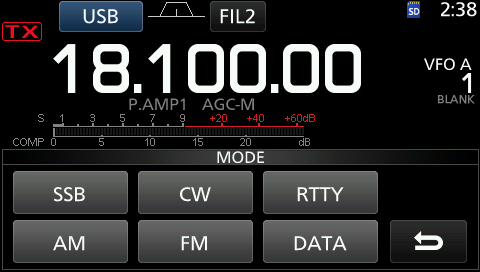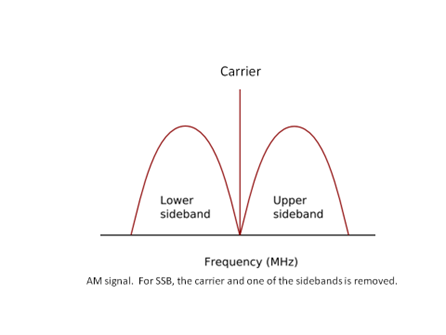What’s a “mode”? The term really has two meanings in ham radio, and the definitions overlap somewhat. An operating mode is a description of what you are doing to send and receive signals. For example, the term phone refers to using your voice on the radio.
Modulation mode refers to the specific method by which information is sent over the air, such as SSB, FM, and AM.
An operating mode may be performed with one or more individual modulation modes. Here’s a chart that shows some of the relationships:
| Operating Mode | Modulation Mode |
| Phone | SSB, AM, FM, Digital Phone (D-STAR, DMR, System Fusion) |
| Digital | RTTY, PSK31, FT8, JT65, Packet (and many more) |
| CW | CW, Computer CW |
If you look closely, you’ll see some examples of the overlap. DMR is both a phone and digital modulation mode. Likewise, you can use a computer to send and decode CW digitally.
It’s possible to use any modulation mode on any band or frequency. However, different modes work better on different bands. For example, FM takes up a significant amount of space in the radio spectrum. That’s why it’s located on 10 meters and above where there’s lots of room.
But wait a minute—aren’t there AM and FM frequency bands? Well, these are also generic names for the radio AM frequency band of 530-1700KHz and FM frequency band 88-108MHz. They’re identified by the mode of broadcast signals transmitted there.
Riding the Wave
Let’s look at the modulation modes available on an HF radio. Press the mode button on the screen of an Icom IC-7300 and you see the following modes listed:

AM (Amplitude Modulation) is the oldest form of voice modulation. When you speak into the microphone of an AM transmitter, the microphone converts your voice into a varying voltage. Amplitude modulation adds this to the carrier, with three separate frequencies being transmitted: the original carrier frequency, a lower sideband (LSB) below the carrier frequency, and an upper sideband (USB) above the carrier frequency. It’s still used by a small group of amateurs, but most ham voice activity on HF has moved to SSB.
SSB (Single Sideband) is a descendant of traditional AM. Compared to AM, SSB is a much more efficient mode since all of the transmitter’s power goes into transmitting useful intelligence. In SSB transmitters, the carrier and one sideband are removed before the signal is amplified. This means an SSB signal only occupies about half the frequency space of a comparable AM signal, allowing more activity on the ham bands.
There are two sidebands, USB (upper) and LSB (lower). On the HF bands above 9 MHz, the voice operation takes place using USB. Below 9 MHz, you find everyone on LSB, except on 60 meters. By putting all of the power into one sideband, the effect on the signal-to-noise ratio is a four-fold (or 6 dB) improvement.

FM (Frequency Modulation) is the mode of choice for local VHF/UHF operations, fixed or mobile, simplex or repeater based. The audio signal modulates the frequency of the transmitter over a small range. It offers good performance with simple equipment requirements. The big advantage of FM is its audio quality and immunity to noise, but it occupies more frequency space than AM or SSB.
CW (Continuous Wave) is the oldest mode of wireless transmission, the simplest, and one of the most efficient. It consists of just turning an unmodulated carrier on and off in a coded pattern that represents characters–the International Morse Code. Technically, it’s a digital mode.
Radioteletype (RTTY ) has been in use longer than any other digital mode except for Morse code. It involves shifting of the carrier between the mark and space to generate characters in the Baudot code, a more elaborate version of Morse code. At the receiver, the Baudot signals originally produced the decoded text on printers. Now radio displays or computer screens are used.
DATA (Digital Modulation) is becoming a popular mode among radio amateurs. The main methods used to modulate digital signals are amplitude shift keying (ASK), frequency shift keying (FSK), and phase shift keying (PSK). Sounds really technical, but it still boils down to basic binary where each shift is a transition from 0 to 1 and 1 to 0–or on/off.
New Frontiers
Transceivers will continue to feature more options as technology continues to improve. If you have an older transceiver, you can operate digital modes by adding sound card interfaces like the Tigertronics SignaLink USB Interface Unit or the RigExpert TI-3000 Digital Mode and Radio Control Interface. Many current transceivers are capable of using both computer control and dedicated data modes. Transceivers with built-in sound cards eliminate the need for an external interface. Either way, you can take advantage of current and new digital modes.
RTTY is a good example of a mode now incorporated into current transceivers. Modern radios like the Icom IC-7300, Yaesu FTDX10, or Kenwood TS-890S can decode through the receiver and send using message memory or a computer. The TS-890S provides the additional option of typing on the fly with a USB keyboard–no computer needed.
Modern digital modes such as FT8 have gained worldwide popularity and account for a large portion of all ham radio activity on the HF bands. It’s a frequency shift keying, digital weak-signal mode used mostly on the HF bands. Using advanced signal processing technology, FT8 can decode signals with a low signal-to-noise ratio much better than CW or SSB. FT4, a variant of FT8, is also gaining a large following and is designed specifically for radio contesting.
What’s Next?
It appears the future of amateur radio modes will continue to be built on software and supported by computers, as well as new generations of full-featured transceivers. These combinations continue to fundamentally change many of the modes we’ll use to make radio contacts. Hardware retrofits and specialized interfaces are becoming a thing of the past.

